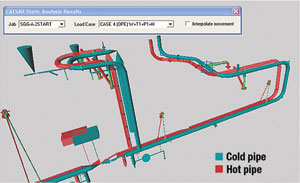 |
| CAESAR II pipe-stress tool plots effects of heat on pipe geometry. (Photo: Black & Veatch) |
Project collaboration is an area where a lot of technology for nuclear powerplant development has emerged since the last wave of U.S. plant construction. The use of unified databases for projects and the development of tools to share data across software systems will change the picture drastically in the future.
“Anything that has to do with collaboration is really key,” says Mark Harmon, chief technology engineer for energy business at Black & Veatch, Overland Park, Kan. He says the rise of standard data formats for collaboration that help engineers exchange data—even complete, intelligent 3D plant models—is making the idea of proprietary software obsolete.
“There is no doubt the new deployment of the next generation of nuclear powerplants in the U. S. will push the capabilities of software and data integration to the next incremental level of complexity,” adds John Atwell, manager of opera-tions at Bechtel Nuclear, Frederick, Md.
James Winters, manager of nuclear systems for the AP1000 at Westinghouse Electric Co., Monroeville, Pa., also talks of collaboration as he praises the richness of data engineers can now store, manipulate, analyze and share. Westinghouse uses Intergraph software for plant design and manages integ-ration through Intergraph’s Foundation tools. It is aided by using its own “intelligent, robust, numbering system for everything,” Winters says. That helps data-map-ping to other systems work consistently.
|
“There’s a lot of exciting stuff happening around interoperability,” says Anne-Marie Walters, global marketing director for Bentley Plant, at Bentley Systems, Exton, Pa. Walters and others particularly praise the accumulating abilities of XMpLant, a file-exchange format.
A decade-long push to develop a vendor-neutral standard data model has led to XMpLant, a taxonomy for plant components, their relationships and their 3D graphical representations that is quite close to providing a 100% exchange mechanism for interoperability, Walters says. The format is embraced by Bentley, AVEVA, Black & Veatch and others. XMpLant was developed privately, based on groundwork by international standards bodies. But it was published publicly by a U.K.-based enterprise called Noumenon that sells development tools for its use.
The model is “a very pragmatic solution,” says Walters. “In this past year, we have really tested it, and it worked very well indeed with a 99% conversion—and the 1% that didn’t automatically convert was very predictable,” she says. “By having everything in a neutral file format, you can have a true neutral electronic record of your plant in a format that isn’t dependent on someone else and doesn’t rapidly change over time. XMpLant, we believe, has gotten to that point now.”
Walters admits, however, that not all Bentley tools can export to it yet. “I know we sound a little bit schizophrenic, but we get the processes working with the formats and the technologies we control, and then we can work integration with XMpLant,” she says.
Black & Veatch has its own privately developed suite of tools, known as POWRTRAK, which store data in its own format, but can export through XMpLant. Harmon predicts the exchange format will be essential in the future, although he puts effectiveness now at about 80% to 85%. But POWRTRAK also exports to the structural steel standard, CIS2, to take models into CAESAR II, a third-party pipe-stress analysis tool from COADE Inc., Houston. CAESAR heats cold pipe to operating conditions of up to 1,000º F to analyze changes.
“The pipe is going to move. You have to design for that,” Harmon explains. “People tend to term POWRTRAK as a proprietary system. In reality, all systems are proprietary. It’s just that our product was privately developed and is not available for commercial sale. Standard data formats like XMpLant kind of removes the stigma of ‘proprietary,’ Harmon says.”
 Related Links:
Related Links: 